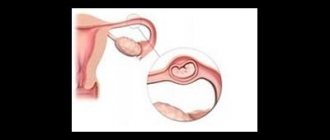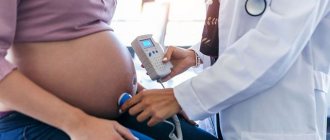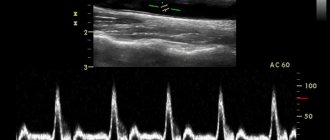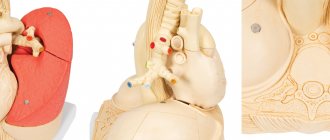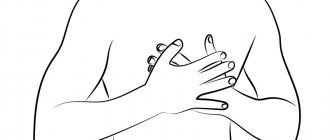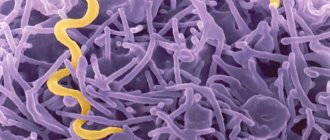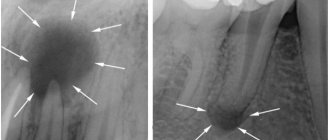General rules
Among the methods of objective examination of the human body, ultrasound rightfully occupies one of the leading places due to the relative simplicity of the examination procedure, painlessness, high information content, non-invasiveness, safety (no radiation), efficiency of research, quick receipt of results, and the possibility of examining the patient in the dynamics of treatment.
The method is based on the principle of directional echolocation, which is based on the ability of tissues/environments of a living organism to reflect/absorb ultrasonic waves. When ultrasonic waves are directed to the area under study, they are reflected from tissues of different acoustic densities, captured by a special sensor and processed on a computer, which makes it possible to visualize the areas of the body under study on the monitor screen. Examination of the abdominal organs (liver, gallbladder, spleen, pancreas, bladder) using ultrasound allows one to assess their condition, identify possible pathologies, the presence of neoplasms, inflammatory foci, traumatic injuries and characteristic changes in organs in chronic diseases, as well as the presence of free fluids (pus, blood, serous fluid) in the abdominal cavity, aneurysmal dilatation of the aorta, enlarged lymph nodes, thrombosis of the portal/inferior vena cava.
However, a high-quality examination of the abdominal organs and obtaining the most reliable data is impossible without prior preparation for the examination. The main factor that distorts the visualization of the examined organs is the air that accumulates in the intestinal loops (intestinal gases), so the main task of preparing for the examination is its removal from the intestines, which is achieved by prescribing a diet and taking, if necessary (for example, for chronic constipation ) enterosorbents /enzymatic preparations aimed at normalizing digestion processes, assimilation of nutrients and reducing gas formation.
The diet before an abdominal ultrasound involves limiting the diet of any fatty foods and foods that contribute to increased gas formation. The diet is prescribed during examination of any abdominal organs, including the liver and gall bladder. Depending on the condition of the intestines, it is recommended to start dietary nutrition 3-5 days before the examination procedure. Below is a list of gas-forming foods that should be completely excluded from the diet:
- milk and dairy products;
- sweets (sweets, sugar);
- black/rye bread, baked goods (buns, cookies, cakes, pies, pastries);
- raw vegetables and fruits, especially cabbage, grapes, plums;
- legumes (peas, beans, lentils);
- drinks containing carbon dioxide, snacks:
- strong coffee and packaged juices;
- fatty types/varieties of fish and meat, meat products (ham, sausages, bacon);
- seasonings and spices, alcohol.
The diet should include boiled poultry (chicken, turkey), beef/veal, and rabbit meat. It is allowed to eat low-fat varieties of sea/river fish, baked or steamed. You can use buckwheat and oatmeal porridge as a side dish. Low-fat hard cheese and 1 hard-boiled egg are allowed. The amount of free fluid is 1.5 l/day. It is recommended to take liquid one hour before or one hour after meals. The diet is fractional, in small portions. The last meal on the eve of the examination (if the procedure is carried out in the morning) should be light. During the examination, a light breakfast is allowed in the afternoon. The examination is carried out on an empty stomach.
If necessary, on the recommendation of a doctor, you can take medications that improve digestion ( Mezim , Festal - 1 tablet or 3 times a day after meals) and reduce gas formation ( Enterosgel , Smecta , Simethicone , Espumisan , Disflatil , Meteospasmil ).
If you are prone to constipation, you can recommend Senade (herbal laxative) taken orally the night before the procedure or Bisacodyl (suppositories). The drugs are taken in the age-specific dosage and according to the regimen given in the instructions for them. If laxatives are ineffective or there is persistent chronic constipation , it is recommended to give a cleansing enema on the eve of the examination (no later than 12 hours before the examination). Before the ultrasound, you should not smoke, chew gum or suck hard candy.
It is prohibited to conduct an ultrasound at least two days after X-ray contrast studies of the gastrointestinal tract, as well as colonoscopy , gastrography , irrigoscopy . If you need to take antispasmodic drugs ( No-shpa , Papaverine , Spazmalgon ), you should warn your doctor and it is advisable to stop them during the study. If additional examination of the kidneys/bladder is necessary, it is necessary to fill the bladder by drinking 0.5 liters of still table water/unsweetened tea an hour before the ultrasound.
Why is an ultrasound prescribed?
At the first suspicion of intra-abdominal diseases, doctors write out a referral for an ultrasound scan. This allows you to detect anomalies such as:
migration of cancerous processes – metastasis;- tumor processes in the pancreas;
- liver cancer;
- cystic formations;
- tissue degeneration, abscesses, internal hemorrhages;
- benign neoplasms;
- pathological accumulation of fluid in the retroperitoneal space.
In order to “catch” the disease at an early stage and quickly take the necessary therapeutic measures, it is necessary to undergo regular examinations, including with the help of ultrasound.
Authorized Products
The diet before an abdominal ultrasound includes non-concentrated broths/soups based on lean chicken and beef with the addition of cereals and vegetables. Dietary varieties of red meat and poultry (chicken, turkey), low-fat varieties of sea/river fish (pike perch, pike, cod, perch) steamed or boiled are allowed.
Buckwheat and oatmeal, white rice, premium wheat pasta, canned/boiled vegetables without peel (carrots, beets, cucumbers, potatoes) may be present as a side dish.
It is allowed to include in the diet hard-boiled eggs or in the form of a steam omelet, butter, unrefined vegetable oils, white bread crackers, mild cheese, diet cookies, compotes without grounds, natural fruit juice without pulp, still table water, dried fruit compotes, ripe melon, honey, natural syrups/jelly, herbal and green tea.
Table of permitted products
| Proteins, g | Fats, g | Carbohydrates, g | Calories, kcal | |
Vegetables and greens | ||||
| potato | 2,0 | 0,4 | 18,1 | 80 |
| boiled carrots | 0,8 | 0,3 | 5,0 | 25 |
Fruits | ||||
| watermelon | 0,6 | 0,1 | 5,8 | 25 |
| melon | 0,6 | 0,3 | 7,4 | 33 |
Cereals and porridges | ||||
| buckwheat | 4,5 | 2,3 | 25,0 | 132 |
| semolina | 3,0 | 3,2 | 15,3 | 98 |
| oatmeal with water | 3,0 | 1,7 | 15,0 | 88 |
| cereals | 11,9 | 7,2 | 69,3 | 366 |
| pearl barley porridge on water | 3,1 | 0,4 | 22,2 | 109 |
| white boiled rice | 2,2 | 0,5 | 24,9 | 116 |
Flour and pasta | ||||
| premium boiled pasta | 3,5 | 0,4 | 23,2 | 112 |
| noodles | 12,0 | 3,7 | 60,1 | 322 |
Bakery products | ||||
| sliced loaf | 7,5 | 2,9 | 50,9 | 264 |
| white bread crackers | 11,2 | 1,4 | 72,2 | 331 |
| wheat bread | 8,1 | 1,0 | 48,8 | 242 |
Confectionery | ||||
| jam | 0,3 | 0,2 | 63,0 | 263 |
| marshmallows | 0,8 | 0,0 | 78,5 | 304 |
| paste | 0,5 | 0,0 | 80,8 | 310 |
Raw materials and seasonings | ||||
| honey | 0,8 | 0,0 | 81,5 | 329 |
| milk sauce | 2,0 | 7,1 | 5,2 | 84 |
Meat products | ||||
| boiled beef | 25,8 | 16,8 | 0,0 | 254 |
| veal | 19,7 | 1,2 | 0,0 | 90 |
Bird | ||||
| boiled chicken breast | 29,8 | 1,8 | 0,5 | 137 |
| boiled chicken drumstick | 27,0 | 5,6 | 0,0 | 158 |
| boiled turkey fillet | 25,0 | 1,0 | — | 130 |
Fish and seafood | ||||
| zander | 19,2 | 0,7 | — | 84 |
| cod | 17,7 | 0,7 | — | 78 |
| pike | 18,4 | 0,8 | — | 82 |
Oils and fats | ||||
| vegetable oil | 0,0 | 99,0 | 0,0 | 899 |
| butter | 0,5 | 82,5 | 0,8 | 748 |
Non-alcoholic drinks | ||||
| green tea | 0,0 | 0,0 | 0,0 | — |
Juices and compotes | ||||
| compote | 0,5 | 0,0 | 19,5 | 81 |
| juice | 0,3 | 0,1 | 9,2 | 40 |
| apricot juice | 0,9 | 0,1 | 9,0 | 38 |
| jelly | 0,2 | 0,0 | 16,7 | 68 |
| pumpkin juice | 0,0 | 0,0 | 9,0 | 38 |
| * data is per 100 g of product | ||||
What factors distort the research results?
There are a number of factors that can distort ultrasound results:
- Failure of the patient to comply with preparation rules. In this case, we are talking not only about giving up certain foods and cleansing the intestines. It is forbidden to smoke 2 hours before the ultrasound examination, chew chewing gum and suck hard candies.
- X-ray examination performed the day before with a contrast agent. You should always warn your doctor about this, otherwise the results will be distorted. It is recommended to wait 2-3 days after the x-ray and only then perform an ultrasound.
- The process of organ imaging reduces the patient's excess body weight.
Remember that all people are individual. If you have any questions, you need to ask them to your doctor, who will give you the recommendations you need.
Fully or partially limited products
The diet before an abdominal ultrasound prohibits all gas-forming foods - fatty meats and meat products (sausages, canned food, ham, bacon), fatty white/red fish, animal fats, marinades, all raw vegetables (cabbage, radishes, onions, garlic , turnips, carrots, beets), garden greens, legumes (beans, lentils, peas, beans), coarse porridges (barley, millet), forest and artificially grown mushrooms, rye bread, sweet fruits (grapes, pear, apple, bananas, tangerines), all types of nuts, dried fruits, berries.
It is prohibited to consume milk and its products - sour cream, cream. Do not include animal/cooking fat, mayonnaise, canned food, chocolate, all types of baked goods and sweets, confectionery products (cakes, pastries, cookies), strong coffee/tea, nectars and juices with pulp, candies, chocolate, drinks, seasonings containing carbon dioxide or caffeine.
Smoked, spicy and fried foods are excluded from the diet, and drinking any alcohol is prohibited.
Table of prohibited products
| Proteins, g | Fats, g | Carbohydrates, g | Calories, kcal | |
Vegetables and greens | ||||
| vegetables legumes | 9,1 | 1,6 | 27,0 | 168 |
| canned vegetables | 1,5 | 0,2 | 5,5 | 30 |
| sauerkraut | 1,8 | 0,1 | 4,4 | 19 |
| white radish | 1,4 | 0,0 | 4,1 | 21 |
| celery (root) | 1,3 | 0,3 | 6,5 | 32 |
| horseradish | 3,2 | 0,4 | 10,5 | 56 |
| garlic | 6,5 | 0,5 | 29,9 | 143 |
| sorrel | 1,5 | 0,3 | 2,9 | 19 |
Fruits | ||||
| bananas | 1,5 | 0,2 | 21,8 | 95 |
Mushrooms | ||||
| mushrooms | 3,5 | 2,0 | 2,5 | 30 |
Nuts and dried fruits | ||||
| nuts | 15,0 | 40,0 | 20,0 | 500 |
| dried fruits | 2,3 | 0,6 | 68,2 | 286 |
| raisin | 2,9 | 0,6 | 66,0 | 264 |
Snacks | ||||
| potato chips | 5,5 | 30,0 | 53,0 | 520 |
| salted popcorn | 7,3 | 13,5 | 62,7 | 407 |
Cereals and porridges | ||||
| oat bran | 8,0 | 4,0 | 10,0 | 110 |
| pearl barley porridge | 3,1 | 0,4 | 22,2 | 109 |
| boiled brown rice | 2,6 | 0,9 | 22,8 | 110 |
| rye bran | 11,2 | 3,2 | 32,0 | 221 |
Flour and pasta | ||||
| vareniki | 7,6 | 2,3 | 18,7 | 155 |
| dumplings | 11,9 | 12,4 | 29,0 | 275 |
Bakery products | ||||
| buns | 7,9 | 9,4 | 55,5 | 339 |
Confectionery | ||||
| cookie | 7,5 | 11,8 | 74,9 | 417 |
| halva | 11,6 | 29,7 | 54,0 | 523 |
Cakes | ||||
| cake | 4,4 | 23,4 | 45,2 | 407 |
Chocolate | ||||
| chocolate | 5,4 | 35,3 | 56,5 | 544 |
Raw materials and seasonings | ||||
| seasonings | 7,0 | 1,9 | 26,0 | 149 |
| mustard | 5,7 | 6,4 | 22,0 | 162 |
| ginger | 1,8 | 0,8 | 15,8 | 80 |
| mayonnaise | 2,4 | 67,0 | 3,9 | 627 |
| ground black pepper | 10,4 | 3,3 | 38,7 | 251 |
| chilli | 2,0 | 0,2 | 9,5 | 40 |
Dairy | ||||
| dairy products | 3,2 | 6,5 | 4,1 | 117 |
| milk | 3,2 | 3,6 | 4,8 | 64 |
| condensed milk | 7,2 | 8,5 | 56,0 | 320 |
| cream 35% (fat) | 2,5 | 35,0 | 3,0 | 337 |
Cheeses and cottage cheese | ||||
| cheese | 24,1 | 29,5 | 0,3 | 363 |
Meat products | ||||
| pork | 16,0 | 21,6 | 0,0 | 259 |
| salo | 2,4 | 89,0 | 0,0 | 797 |
| bacon | 23,0 | 45,0 | 0,0 | 500 |
| ham | 22,6 | 20,9 | 0,0 | 279 |
Sausages | ||||
| smoked sausage | 28,2 | 27,5 | 0,0 | 360 |
| dry-cured sausage | 24,1 | 38,3 | 1,0 | 455 |
| sausages | 10,1 | 31,6 | 1,9 | 332 |
Bird | ||||
| fried chicken | 26,0 | 12,0 | 0,0 | 210 |
| smoked chicken | 27,5 | 8,2 | 0,0 | 184 |
| duck | 16,5 | 61,2 | 0,0 | 346 |
| goose | 16,1 | 33,3 | 0,0 | 364 |
Fish and seafood | ||||
| smoked fish | 26,8 | 9,9 | 0,0 | 196 |
| pink salmon | 20,5 | 6,5 | 0,0 | 142 |
| Red caviar | 32,0 | 15,0 | 0,0 | 263 |
| canned fish | 17,5 | 2,0 | 0,0 | 88 |
| herring | 16,3 | 10,7 | — | 161 |
| salmon | 21,6 | 6,0 | — | 140 |
Oils and fats | ||||
| cooking fat | 0,0 | 99,7 | 0,0 | 897 |
Alcoholic drinks | ||||
| dry white wine | 0,1 | 0,0 | 0,6 | 66 |
| red dessert wine | 0,5 | 0,0 | 20,0 | 172 |
| dry red wine | 0,2 | 0,0 | 0,3 | 68 |
| vodka | 0,0 | 0,0 | 0,1 | 235 |
| cognac | 0,0 | 0,0 | 0,1 | 239 |
| beer | 0,3 | 0,0 | 4,6 | 42 |
Non-alcoholic drinks | ||||
| bread kvass | 0,2 | 0,0 | 5,2 | 27 |
| cola | 0,0 | 0,0 | 10,4 | 42 |
| sprite | 0,1 | 0,0 | 7,0 | 29 |
| tonic | 0,0 | 0,0 | 8,3 | 34 |
| Fanta | 0,0 | 0,0 | 11,7 | 48 |
Juices and compotes | ||||
| grape juice | 0,3 | 0,0 | 14,0 | 54 |
| * data is per 100 g of product | ||||
Features of child preparation
There are certain differences in the preparation of adult patients and children. If an ultrasound of the BBP is performed in an adult after 12 hours from the last meal, then in children this period is reduced. Moreover, the younger the child’s age, the shorter the time interval between the last meal and the ultrasound should be.
For example, children under one year old can be examined 3 hours after the last feeding or immediately before feeding. After a year, it is better to at least 4-6 hours after the last meal.
Therefore, ultrasounds for children are performed mainly in the morning, so that after the ultrasound the child can be fed immediately.
Results and reviews
The diet in preparation for an ultrasound of the abdominal organs, according to reviews from people who have undergone such a study, is easily tolerated, does not require the preparation of special dishes and allows you to obtain reliable information about the state of the gastrointestinal tract.
- “... I suffered from hepatitis. After treatment, I still continue to feel heaviness in my right hypochondrium. An ultrasound of the liver and gallbladder was prescribed. Before the study, I was on a diet for 3 days. An ultrasound revealed stones in the gall bladder, now I’m consulting and thinking about what to do with them next”;
- “...I undergo ultrasound of the gallbladder at least 2 times a year. I have been suffering from cholecystitis for a long time, but I am in no hurry to undergo surgery; I periodically monitor the condition of the stones and their dynamics. I am on a diet almost constantly, and not just during the period of preparation for an ultrasound. As soon as heaviness appears under the rib and bitterness in the mouth, I immediately go on a diet, without leading to an aggravation, and during the period of preparation for the ultrasound I limit the diet, excluding all gas-forming foods, fatty foods, flour and sweets. The doctor recommends removing the gallbladder, but I haven’t decided yet, after all, it was given to a person for a reason.”
Basic rules for preparing for an ultrasound of the abdominal organs
Preparation before an ultrasound examination is an integral part of a full examination. It will make the diagnosis as informative as possible; for this you need to follow a number of simple recommendations.
It is advisable to prepare for ultrasound in advance - ideally 3-4 days before the procedure. This period will allow you to normalize your diet and cleanse your intestines, because the presence of gases in it can greatly limit the possibilities of a full examination.
6-12 hours before the ultrasound you need to stop eating. You need to come to the office on an empty stomach, i.e. not only do not drink or eat, but also do not chew gum or smoke before the procedure.
In order to properly prepare your body for an ultrasound examination, you need to change your diet a few days before the ultrasound, excluding a certain list of foods from it. It is very important to prepare the intestines, which should not contain gases.



